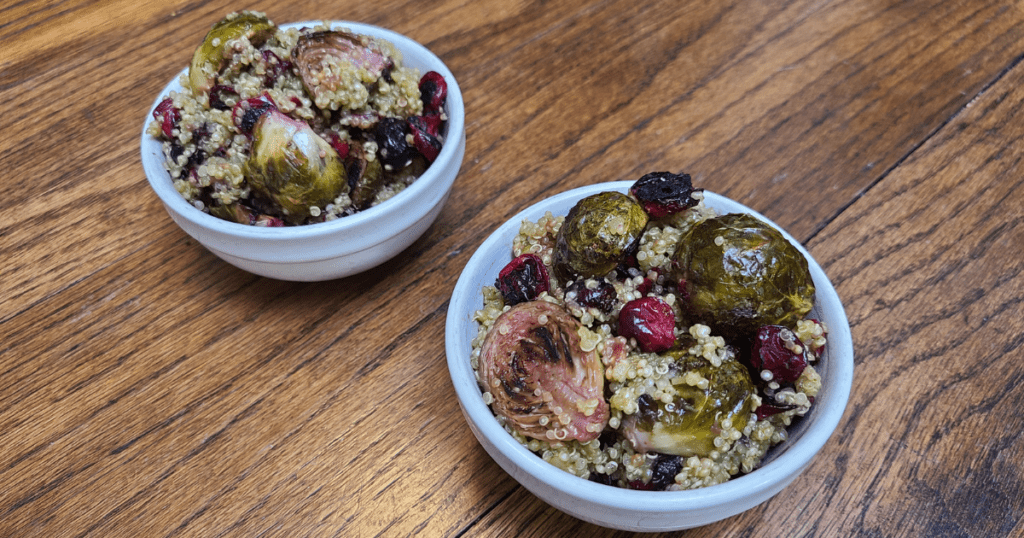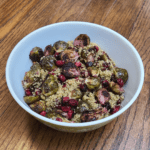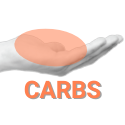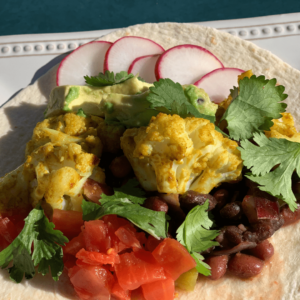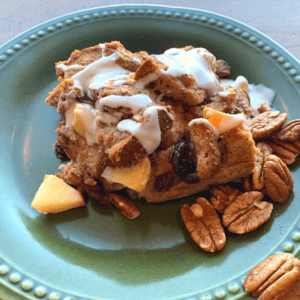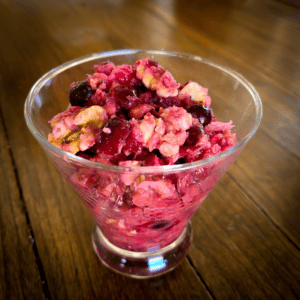Quinoa Pilaf with Roasted Brussels Sprouts and Cranberries
I had some fresh cranberries kicking around the freezer, left over from the holiday recipes, and I was dreaming of how I could use them. I wondered if I could make roasted brussels sprouts and cranberries on the same sheet pan, and... it totally worked!
Long story short, roasting cranberries is just as transformational as it is for the brussels sprouts. I just tossed them each with a little bit of olive oil, and popped them in the oven like my regular sheet pan roasted veggies at 425F for 30 minutes.
Nutrition density & “functional food”
Nutrition density refers to the ratio of beneficial nutrients in foods to the calorie level in a normal serving size. In other words, when something is “nutrient dense” you get more nutritional bang for relatively low calories. (Conversely, examples of low-nutrient and energy-dense items are sugar-sweetened beverages and highly processed high fat foods, which is why they’re often called “junk food” but can simply be characterized as treats.)
The idea of functional food is becoming more popular as people begin to realize that some foods have particular, well-defined physical or physiological benefits beyond basic nutrition. Functional foods are often particularly rich in nutrients like dietary fiber, omega-3 fatty acids, vitamins, and phytochemicals (biologically active compounds found in plants) that work with or strengthen the body's natural systems.
These benefits not only promote optimal health but can be powerful enough to reduce the risk of chronic diseases such as diabetes, heart disease, and even cancer.
This quinoa pilaf with roasted brussels sprouts and cranberries brings together nutrient density and the qualities of functional food. In particular, the fiber content of each of these ingredients can aid in lowering cholesterol levels and promoting a healthy gut microbiome.
So, Brussels Sprouts… love 'em or hate 'em?
If you’re remembering old steamed Brussel sprouts from when you were a kid (and maybe tried to roll off the edge of the table into the electric heater? Oh just me? Wait that was lima beans… Ok 🤣 )
In the past, people have been reluctant to eat these vegetables because of their smell, but these are not just plain old steamed Brussel sprouts that everyone tried to feed their dog under the table when they were a kid. The popularity of roasted brussels sprouts has been on the rise in recent years. This is mainly because they legitimately taste better than they used to.
I like things to be easy… easy to prep and easy to clean up. Brussels sprouts can be skillet roasted as an option, but I like the ease and convenience of roasting them in the oven on sheet pan lined with baking parchment paper. Just pop it in, and it’s ready when the time goes off, freeing me to do something else in the meantime.
As for the nutritional benefits, these mini-cabages have a lot. Brussels sprouts are low in calories but high in many nutrients, especially fiber, vitamin K and vitamin C.
Now you might be thinking, “but the smell!” You’ll be glad to know this…
And for what’s remaining, roasting converts some of the sulfur compounds that contribute to their strong smell to bring out a savory nutty flavor. Here’s how!
The tasty science of roasting, caramelization and the Maillard reaction
Welcome to a quick Cooking Chemistry lesson. You may be familiar with the idea of Caramelization, which occurs when carbohydrates reduce (lose water) causing the molecules change shape at high temperatures, These changes produce different textures, flavors and the classic browned color.
There is another kind of browning transformation when proteins are involved with these reducing carbohydrates, called a Maillard Reaction (pronounced my-YAR). When food is heated above 300F, hundreds of complex aroma and flavor molecules are produced, creating new flavor profiles and a delectable browned appearance. Though brussels sprouts aren’t normally considered high protein, because their proteins include sulfur, they also undergo a maillard reaction transforming the pungent elements into savory properties.
Roasting cranberries??
We normally only think of cranberries as a holiday condiment, but because of their incredible nutritional value I wanted to branch out to a more year round presentation.
Like brussels sprouts, cranberries are one of those foods where you’re not sure if they can be made any better, but then someone cooks them just the right way and then you’re hooked for life.
Roasting cranberries is a new way of preparing them that's as delicious as it is easy. Just spread them on a baking sheet and pop them into the oven.
While it is widely acknowledged that cranberries are just chock full of antioxidants , it is less well know that many of these compounds are concentrated in the skin. This means the nutrition density is greatly reduced when juiced, and for that reason eating whole cranberries gives you way more of these bioactive plant compounds.
The main benefit of roasting cranberries is that no sugar is needed to make them palatable. Again, just like brussels sprouts lose their bitter aftertaste, roasting tones down the sour and tart tendencies of raw cranberries to reveal their natural sweetness.
Quinoa, healthy, easy, and delicious!
Though quinoa is technically classified as a seed, the culinary and nutritional treatment is as a grain. Quinoa is one of the most nutrient dense grains, boasting a 15% protein content with a well balanced amino acid profile. That means it is a “complete” protein, which is especially relevant for people eating a plant based diet.
Quinoa is naturally gluten-free and also suitable for a low-FODMAP diet, being low in the fermentable carbohydrates that can cause bloating and sensitivity in people with irritable bowel syndrome (IBS) and Crohn's disease.
But how does it taste?
Quinoa has a mild, slightly nutty flavor of it’s own, and easily absorbs seasonings. It has an appealing texture that is fluffy and chewy at the same time.
Of note, quinoa seeds are naturally coated with saponins, which are chemicals plants produce to protect themselves from diseases. Since saponins can have a bitter, soapy taste, and might upset the stomach, quinoa should be rinsed thoroughly in cold water before it is cooked. Packaged quinoa is usually pre-rinsed, but if not, rinse under cool running water using a fine mesh strainer before cooking.
As far as quick and easy, the cooking time of quinoa is shorter than rice. It only takes about 10 or 12 minutes to absorb cooking liquid, although you may choose to pan toast the dry grain first.
What makes something a “Pilaf”?
To intensify the flavor of a nutty grain like quinoa, you can pan toast them before cooking to add depth to the flavor of a dish. Then, when you simmer it in a broth or stock you have created a savory quinoa pilaf.
To sum up…
When brussels sprouts and cranberries are paired with quinoa, we're talking superfood central here. I hope you enjoy this recipe, and if you try it, let me know what you think in the comments!
Mealtime conversation starters
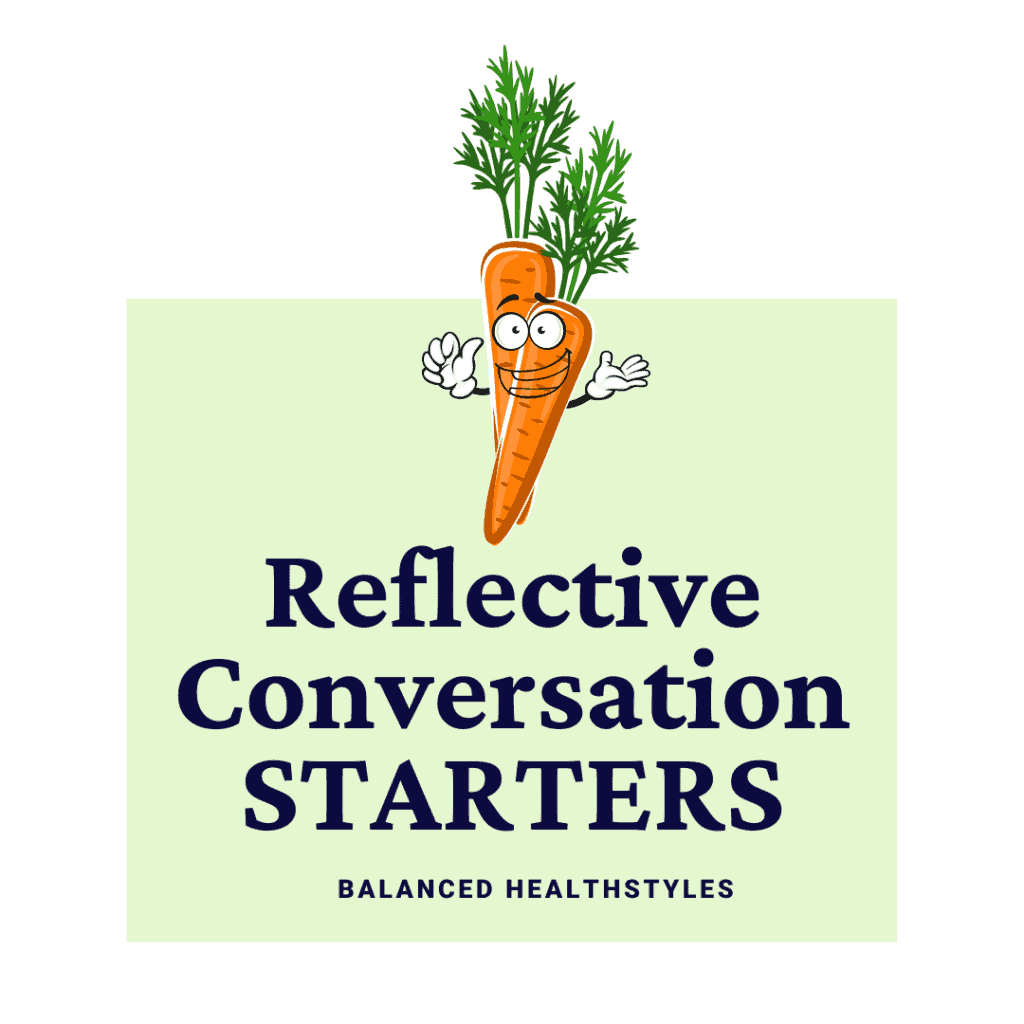
Questions show interest, create understanding, and build rapport between people. A thoughtfully asked question is a great way to show someone you care about them and creates a wonderful opportunity for you to respond to what they are revealing in their answer.
Here’s a curious question that can help break the ice with someone or foster a deeper connection:
Question- What would be the title of your autobiography?
Quinoa Pilaf with Roasted Brussels Sprouts and Cranberries
In case there's a piece of equipment or ingredient that you don't have, you can conveniently order it by clicking on the item. Balanced Healthstyles may earn on qualified purchases, which help maintain the free resources on this site -- Thanks for your support!
Equipment
Ingredients
- 1 pound Brussels sprouts
- 2 cups whole cranberries (fresh or frozen)
- 2 tbsp olive oil
- 1 cup quinoa
- 2 cups vegetable broth
- 1 tbsp chimichurri
Instructions
Sheet Pan brussels sprouts and cranberries
- Preheat the oven to 425°F. Line a large, rimmed baking sheet with parchment paper for easy cleanup
- Trim the tough stem ends of your Brussels sprouts and remove any discolored or broken leaves. Then, from the trimmed base to the top, cut each sprout in half lengthwise.
- Drizzle with 1 tablespoon of olive oil and toss to evenly coat. Arrange the sprouts in a single layer, flat sides down. Toss the cranberries with the other tablespoon of the oil, and pour them around the sprouts.
- Roast in the hot oven for 30 minutes.
Quinoa Pilaf
- While the sprouts are cooking, place dry quinoa in a pot or skillet big enough that it forms a shallow layer, and toast over medium heat, shaking or stirring every minute or so, for about 15 minutes or until the grains start to brown.
- Add vegetable broth and bring to a boil then decrease the heat to a gentle simmer. Cover and cook until the liquid is absorbed, 10-15 minutes then remove from heat. Allow to steam for 5 minutes then fluff with a fork.
- Stir in chimichurri to coat, then fold in roasted brussels sprouts and cranberries.
- Best served immediately, or at room temperature.
Notes
Hand Size Portions
Hand Portions
Some handy advice: You can use your hands to practice calorie control without weighing and measuring.
Using hand position size is an alternative way to decide how much to eat visually. It gives you a way to quickly estimate what's on your plate, using the size of your hand as an alternative to counting macros (which generally has you weighing and reading nutrition labels to count protein, carbohydrates, and fat).
To learn more, read How to Get Started with Hand Portion Sizes.
Heather Lynn Darby helps office and tech professionals disrupt the cycle of chronic stress that undermines their health, and to recover from the negative effects of sitting at a computer all day. Find other articles written by Heather on her coach profile.
If you are largely sedentary at work and rely on your intellectual acumen for success, her take on body-mind interventions will help you find a balance between being "in the zone" and getting the amount of movement that will optimize your mental productivity and prevent health problems.


